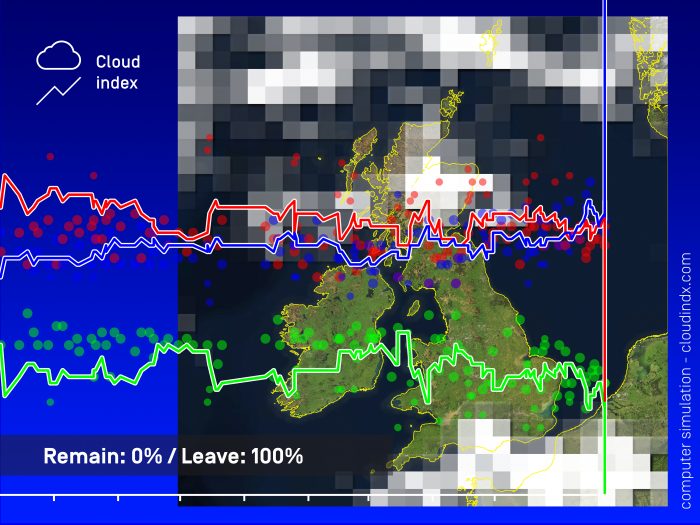Cloud Index is the third digital commission by the Serpentine Galleries, London. It is available in its entirety online, accompanied by essays on the technology and history of machine learning and weather forecasting.

For some time, I’ve been fascinated with the physical infrastructure of the internet, and particularly the assemblage of what we’ve come to call “the cloud”: the vast networks of cables and servers inside huge warehouses which power the heavy computation required to run the modern world. This infrastructure is often hidden, for reasons of business, security, and aesthetics, and corresponds to the opaque nature of technology itself, its inscrutability and lack of general public comprehension from the black boxes of mobile phones to computer code itself. This opacity of “the cloud” is a problem when technology is political, and one of the primary shapers of contemporary life. But, like computer code, making visible the infrastructure is an opportunity to understand and explore it: comprehending it can increase agency too. The history of this infrastructure is one of increasing complexity and geographical scope over time, not miniaturising, but expanding from mainframe computers to satellite networks, gradually coming to cover the entire earth.
The history of this cloud is intimately bound up with real and artificial clouds: from climate activity to the atomic bomb. The first digital computers were designed for two main purposes: simulating atomic explosions and predicting the weather. The women and men who worked on these machines recognised and campaigned for the adoption of digital computation into every possible sphere of life, in a form of utopian technological thinking which has shaped the core narrative of the twenty-first century: that processing and automation by machines will not only replace human thought and action in every domain, but that it is morally and ethically superior as well, and separable from the flaws and biases of human intention. Technology is politics by other means.
The history of weather prediction is, in turn, bound up with the history of weather control. This is the idea that we can manipulate climate conditions for our own benefits. The history of weather control extends back to rain-makers and ancient augurs, and continues into the present with cloud-seeding – used extensively in, for example, China to prevent rain at the Beijing Olympics and during state ceremonies – and proposals for geo-engineering. Geo-engineering is the next great debate we are going to have in climate change. When it becomes clear to more people that the warming process is inevitable, direct intervention – in forms such as seeding the oceans with algae or increasing cloud cover to reflect more of the sun’s energy – will become a realistic, if a controversial, proposal. Evaluating such proposals requires, like an understanding of climate change itself, a literacy in data and computation, the lingua franca of power today. How we choose to deploy the technologies we are capable of building will determine whether we survive them. If we are capable of predicting outcomes in the world by modelling and simulating the results of surveillance and remote sensing, how far should we go to control and change those outcomes? Data is the atomic bomb of the twenty-first century.
Weather control is an extension of the idea that we can understand the world by gathering as much data as possible about it, modelling it to ever finer degrees, calculating every possible outcome, and use existing knowledge to predict and control it. This data-driven ontology is a way of seeing and acting in the world, and is the key to understanding contemporary scientific practice, architecture and design, the surveillance state, neoliberal economics, and media discourse. But it is also, in many ways, failing – failing to produce the expected equilibrium and equality it claims – and one of the reasons that it is failing is that it cannot account for the inherent plurality and complexity of the world itself, the reality revealed by our increasingly accurate and widespread technologies. My contention is that this reality is what we are really pointing to when we talk about “the cloud”; a reality that is “clouded”: diffuse, shifting, and ultimately unknowable.
This unknowability makes us uncomfortable and irrational. From the debate over climate change, to online conspiracy theories, to increasing fundamentalisms, to the “post-factual” landscape of British politics, our inability to synthesise the vast troves of information available to us is destroying our ability to act meaningfully in the world. Instead of data-driven knowledge, we need a cloud knowledge: a mode of being in and thinking through the world which does not assume mastery and control as its final outcome, but is aware of and comfortable with the vast, unknowable complexity of the world.
– Cloud Index
– On the Technology of the Cloud Index
– Cloud History, Cloud Thinking
Comments are closed. Feel free to email if you have something to say, or leave a trackback from your own site.